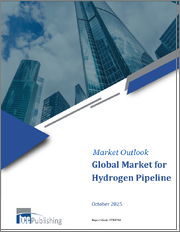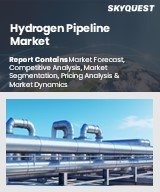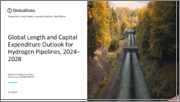
|
시장보고서
상품코드
1732054
세계의 수소 파이프라인 시장 조사 보고서 : 산업 분석, 규모, 점유율, 성장, 동향, 예측(2025-2033년)Global Hydrogen Pipeline Market Research Report- Industry Analysis, Size, Share, Growth, Trends and Forecast 2025 to 2033 |
||||||
수소 파이프라인 세계 시장 규모는 2024년 110억 8,000만 달러에서 2033년 429억 달러로 2026-2033년 예측 기간 동안 16.23%의 견고한 연평균 성장률(CAGR)을 기록할 것으로 예상됩니다.
수소 파이프라인 시장은 청정에너지와 탈탄소화에 대한 전 세계의 관심이 높아짐에 따라 크게 성장하고 있습니다. 수소는 운송, 산업 공정, 에너지 저장을 위한 다목적 연료로 작용하며 지속가능한 에너지 시스템으로 전환하는 데 있어 중요한 요소라는 인식이 확산되고 있습니다. 국가와 산업계가 이산화탄소 배출량 감축을 목표로 하는 가운데, 수송 및 유통을 위한 파이프라인을 포함한 수소 인프라에 대한 수요가 급증하여 시장 확대의 원동력이 될 것으로 예상됩니다.
기술의 발전은 수소 파이프라인 시장 형성에 중요한 역할을 하고 있습니다. 파이프라인 재료, 건설 기술, 안전 모니터링 시스템의 혁신은 수소 수송의 효율성과 신뢰성을 높이고 있습니다. 첨단 복합재료와 코팅의 개발로 파이프라인의 내구성이 향상되어 수소의 고유한 특성을 견딜 수 있게 되었습니다. 또한, 스마트 모니터링 기술의 통합으로 파이프라인의 상태를 실시간으로 평가하여 안전하고 효율적인 운영을 보장할 수 있게 되었습니다. 이러한 기술이 계속 발전함에 따라 수소 파이프라인의 기능이 강화될 뿐만 아니라 에너지, 운송, 산업 제조 등 다양한 분야에서 활용도가 확대될 것입니다.
또한, 수소 파이프라인 시장은 수소 인프라에 대한 투자 증가와 지원적인 규제 프레임워크의 혜택을 누리고 있습니다. 각국 정부가 수소 경제 국가 개발을 우선시하고 청정에너지 솔루션을 촉진하는 정책을 시행함에 따라 수소 파이프라인에 대한 수요는 증가할 것으로 예상됩니다. 이러한 추세는 에너지 기업, 인프라 개발 기업, 규제 기관 간의 협력을 촉진하고 종합적인 수소 운송 네트워크의 개발을 촉진할 것으로 보입니다. 기술 발전, 시장 수요, 규제 당국의 지원이 결합되면 수소 파이프라인 분야는 지속적인 성장을 통해 청정에너지의 미래에 큰 기여를 할 것입니다.
당사의 보고서는 고객에게 다양한 산업 및 시장에 대한 포괄적이고 실용적인 인사이트를 제공하기 위해 세심하게 작성되었습니다. 각 보고서는 시장 상황을 완전히 이해하기 위해 몇 가지 중요한 요소를 포함하고 있습니다:
시장 개요 : 정의, 분류, 산업 현황 등 시장에 대한 자세한 소개.
시장 촉진요인 : 시장 성장에 영향을 미치는 주요 촉진요인, 억제요인, 시장 촉진요인 및 과제를 상세히 분석합니다. 이 섹션에서는 기술 발전, 규제 변화, 새로운 트렌드 등의 요인을 검토합니다.
세분화 분석 : 제품 유형, 용도, 최종사용자, 지역 등의 기준에 따라 시장을 명확한 부문으로 분류합니다. 이 분석을 통해 각 부문의 성과와 잠재력을 파악할 수 있습니다.
경쟁 환경 : 시장 점유율, 제품 포트폴리오, 전략적 이니셔티브, 재무 실적 등 주요 시장 플레이어에 대한 종합적인 평가. 주요 기업들이 채택하고 있는 경쟁 역학 및 주요 전략에 대한 인사이트를 제공합니다.
시장 예측 : 과거 데이터와 현재 시장 상황을 바탕으로 일정 기간 동안 시장 규모와 성장 추세를 예측합니다. 여기에는 정량적 분석과 향후 시장 궤적을 보여주는 그래프 표시가 포함됩니다.
지역 분석 : 지역별 시장 성과를 평가하고 주요 시장 및 지역 동향을 파악할 수 있습니다. 지역 시장 역학 및 비즈니스 기회를 이해하는 데 도움이 됩니다.
새로운 트렌드와 기회 : 현재 시장 동향과 새로운 시장 동향, 기술 혁신, 잠재적 투자 대상 분야를 파악합니다. 향후 시장 개척 및 성장 전망에 대한 인사이트를 제공합니다.
목차
제1장 서문
제2장 주요 요약
- 시장 하이라이트
- 세계 시장 현황
제3장 수소 파이프라인 산업 분석
- 소개 : 시장 역학
- 시장 성장 촉진요인
- 시장 성장 억제요인
- 기회
- 업계 동향
- Five Forces 분석
- 시장 매력 분석
제4장 밸류체인 분석
- 밸류체인 분석
- 원재료 분석
- 원재료 리스트
- 원재료 제조업체 리스트
- 주요 원재료 가격 동향
- 잠재적 바이어 리스트
- 마케팅 채널
- 직접 마케팅
- 간접 마케팅
- 마케팅 채널 발전 동향
제5장 수소 파이프라인 세계 시장 분석 : 유형별
- 개요 : 유형별
- 실적과 예측 데이터 분석 : 유형별
- 이동식 파이프라인
- 고정형 파이프라인
제6장 수소 파이프라인 세계 시장 분석 : 거리별
- 개요 : 거리별
- 실적과 예측 데이터 분석 : 거리별
- 300km 이하
- 300Km 이상
제7장 세계의 수소 파이프라인 시장 분석 : 수소 형태별
- 개요 : 수소 형태별
- 실적과 예측 데이터 분석 : 수소 형태별
- 가스
- 액체
제8장 수소 파이프라인 세계 시장 분석 : 구조별
- 개요 : 구조별
- 실적과 예측 데이터 분석 : 구조별
- 금속
- 플라스틱·복합재료
제9장 수소 파이프라인 세계 시장 분석 : 지역별
- 지역별 전망
- 소개
- 북미의 매출 분석
- 개요, 실적과 예측
- 북미 : 부문별
- 북미 : 국가별
- 미국
- 캐나다
- 멕시코
- 유럽의 매출 분석
- 개요, 실적과 예측
- 유럽 : 부문별
- 유럽 : 국가별
- 영국
- 프랑스
- 독일
- 이탈리아
- 러시아
- 기타 유럽
- 아시아태평양의 매출 분석
- 개요, 실적과 예측
- 아시아태평양 : 부문별
- 아시아태평양 : 국가별
- 중국
- 인도
- 일본
- 한국
- 호주
- 동남아시아
- 기타 아시아태평양
- 라틴아메리카의 매출 분석
- 개요, 실적과 예측
- 라틴아메리카 : 부문별
- 라틴아메리카 : 국가별
- 브라질
- 아르헨티나
- 페루
- 칠레
- 기타 라틴아메리카
- 중동 및 아프리카의 매출 분석
- 개요, 실적과 예측
- 중동 및 아프리카 : 부문별
- 중동 및 아프리카 : 국가별
- 사우디아라비아
- 아랍에미리트
- 이스라엘
- 남아프리카공화국
- 기타 중동 및 아프리카
제10장 수소 파이프라인 기업 경쟁 구도
- 수소 파이프라인 시장 경쟁
- 제휴·협력·협정
- 인수합병
- 신제품 발매
- 기타 개발
제11장 기업 개요
- 상위 기업의 시장 점유율 분석
- 시장 집중도
- Cenergy Holdings
- SoluForce B.V.
- Salzgitter AG
- Gruppo Sarplast S.R.L
- Tenaris
- Hexagon Purus
- Pipelife International GmbH
- Europe Technologies
- H2 Clipper Inc.
- NPROXX
- GF Piping Systems
- ArcelorMittal
- Jindal Saw Limited
Global Hydrogen Pipeline Market size is anticipated to grow from USD 11.08 Billion in 2024 to USD 42.9 Billion by 2033, showcasing a robust Compound Annual Growth Rate (CAGR) of 16.23% during the forecast period of 2026 to 2033.
The hydrogen pipeline market is poised for significant growth as the global focus on clean energy and decarbonization intensifies. Hydrogen is increasingly recognized as a key component in the transition to sustainable energy systems, serving as a versatile fuel for transportation, industrial processes, and energy storage. As countries and industries seek to reduce their carbon footprints, the demand for hydrogen infrastructure, including pipelines for transportation and distribution, is expected to surge, driving market expansion.
Technological advancements are playing a crucial role in shaping the hydrogen pipeline market. Innovations in pipeline materials, construction techniques, and safety monitoring systems are enhancing the efficiency and reliability of hydrogen transportation. The development of advanced composite materials and coatings is improving the durability of pipelines, allowing them to withstand the unique properties of hydrogen. Additionally, the integration of smart monitoring technologies is enabling real-time assessment of pipeline integrity, ensuring safe and efficient operation. As these technologies continue to evolve, they will not only enhance the capabilities of hydrogen pipelines but also expand their applications across various sectors, including energy, transportation, and industrial manufacturing.
Moreover, the hydrogen pipeline market is benefiting from increasing investments in hydrogen infrastructure and supportive regulatory frameworks. As governments prioritize the development of hydrogen economies and implement policies to promote clean energy solutions, the demand for hydrogen pipelines is expected to rise. This trend is likely to drive collaboration between energy companies, infrastructure developers, and regulatory bodies, fostering the development of comprehensive hydrogen transportation networks. The convergence of technological advancements, market demand, and regulatory support positions the hydrogen pipeline sector for sustained growth and significant contributions to the future of clean energy.
Our reports are meticulously crafted to provide clients with comprehensive and actionable insights into various industries and markets. Each report encompasses several critical components to ensure a thorough understanding of the market landscape:
Market Overview: A detailed introduction to the market, including definitions, classifications, and an overview of the industry's current state.
Market Dynamics: In-depth analysis of key drivers, restraints, opportunities, and challenges influencing market growth. This section examines factors such as technological advancements, regulatory changes, and emerging trends.
Segmentation Analysis: Breakdown of the market into distinct segments based on criteria like product type, application, end-user, and geography. This analysis highlights the performance and potential of each segment.
Competitive Landscape: Comprehensive assessment of major market players, including their market share, product portfolio, strategic initiatives, and financial performance. This section provides insights into the competitive dynamics and key strategies adopted by leading companies.
Market Forecast: Projections of market size and growth trends over a specified period, based on historical data and current market conditions. This includes quantitative analyses and graphical representations to illustrate future market trajectories.
Regional Analysis: Evaluation of market performance across different geographical regions, identifying key markets and regional trends. This helps in understanding regional market dynamics and opportunities.
Emerging Trends and Opportunities: Identification of current and emerging market trends, technological innovations, and potential areas for investment. This section offers insights into future market developments and growth prospects.
SEGMENTATION COVERED IN THE REPORT
By Type
- Mobile Pipelines
- Fixed Pipelines
By Distance
- Upto 300 Km
- More than 300 Km
By Hydrogen form
- Gas
- Liquid
- By structure
- Metal
- Plastics & Composites
- COMPANIES PROFILED
- Cenergy Holdings
- SoluForce B.V.
- Salzgitter AG
- Gruppo Sarplast S.r.l
- Tenaris
- Hexagon Purus
- Pipelife International GmbH
- Europe Technologies
- H2 Clipper Inc.
- NPROXX
- GF Piping Systems
- ArcelorMittal
- Jindal Saw Limited.
- The above list can be customized.
TABLE OF CONTENTS
1. PREFACE
- 1.1. Report Description
- 1.1.1 Objective
- 1.1.2 Target Audience
- 1.1.3 Unique Selling Proposition (USP) & offerings
- 1.2. Research Scope
- 1.3. Research Methodology
- 1.3.1 Market Research Process
- 1.3.2 Market Research Methodology
2. EXECUTIVE SUMMARY
- 2.1. Highlights of Market
- 2.2. Global Market Snapshot
3. HYDROGEN PIPELINE INDUSTRY ANALYSIS
- 3.1. Introduction - Market Dynamics
- 3.2. Market Drivers
- 3.3. Market Restraints
- 3.4. Opportunities
- 3.5. Industry Trends
- 3.6. Poerter's Five Force Analysis
- 3.7. Market Attractiveness Analysis
- 3.7.1 Market Attractiveness Analysis By Type
- 3.7.2 Market Attractiveness Analysis By Distance
- 3.7.3 Market Attractiveness Analysis By Hydrogen form
- 3.7.4 Market Attractiveness Analysis By structure
- 3.7.5 Market Attractiveness Analysis By Region
4. VALUE CHAIN ANALYSIS
- 4.1. Value Chain Analysis
- 4.2. Raw Material Analysis
- 4.2.1 List of Raw Materials
- 4.2.2 Raw Material Manufactures List
- 4.2.3 Price Trend of Key Raw Materials
- 4.3. List of Potential Buyers
- 4.4. Marketing Channel
- 4.4.1 Direct Marketing
- 4.4.2 Indirect Marketing
- 4.4.3 Marketing Channel Development Trend
5. GLOBAL HYDROGEN PIPELINE MARKET ANALYSIS BY TYPE
- 5.1. Overview By Type
- 5.2. Historical and Forecast Data Analysis By Type
- 5.3. Mobile Pipelines Historic and Forecast Sales By Regions
- 5.4. Fixed Pipelines Historic and Forecast Sales By Regions
6. GLOBAL HYDROGEN PIPELINE MARKET ANALYSIS BY DISTANCE
- 6.1. Overview By Distance
- 6.2. Historical and Forecast Data Analysis By Distance
- 6.3. Upto 300 Km Historic and Forecast Sales By Regions
- 6.4. More than 300 Km Historic and Forecast Sales By Regions
7. GLOBAL HYDROGEN PIPELINE MARKET ANALYSIS BY HYDROGEN FORM
- 7.1. Overview By Hydrogen form
- 7.2. Historical and Forecast Data Analysis By Hydrogen form
- 7.3. Gas Historic and Forecast Sales By Regions
- 7.4. Liquid Historic and Forecast Sales By Regions
8. GLOBAL HYDROGEN PIPELINE MARKET ANALYSIS BY STRUCTURE
- 8.1. Overview By structure
- 8.2. Historical and Forecast Data Analysis By structure
- 8.3. Metal Historic and Forecast Sales By Regions
- 8.4. Plastics & Composites Historic and Forecast Sales By Regions
9. GLOBAL HYDROGEN PIPELINE MARKET ANALYSIS BY GEOGRAPHY
- 9.1. Regional Outlook
- 9.2. Introduction
- 9.3. North America Sales Analysis
- 9.3.1 Overview, Historic and Forecast Data Sales Analysis
- 9.3.2 North America By Segment Sales Analysis
- 9.3.3 North America By Country Sales Analysis
- 9.3.4 United States Sales Analysis
- 9.3.5 Canada Sales Analysis
- 9.3.6 Mexico Sales Analysis
- 9.4. Europe Sales Analysis
- 9.4.1 Overview, Historic and Forecast Data Sales Analysis
- 9.4.2 Europe By Segment Sales Analysis
- 9.4.3 Europe By Country Sales Analysis
- 9.4.4 United Kingdom Sales Analysis
- 9.4.5 France Sales Analysis
- 9.4.6 Germany Sales Analysis
- 9.4.7 Italy Sales Analysis
- 9.4.8 Russia Sales Analysis
- 9.4.9 Rest Of Europe Sales Analysis
- 9.5. Asia Pacific Sales Analysis
- 9.5.1 Overview, Historic and Forecast Data Sales Analysis
- 9.5.2 Asia Pacific By Segment Sales Analysis
- 9.5.3 Asia Pacific By Country Sales Analysis
- 9.5.4 China Sales Analysis
- 9.5.5 India Sales Analysis
- 9.5.6 Japan Sales Analysis
- 9.5.7 South Korea Sales Analysis
- 9.5.8 Australia Sales Analysis
- 9.5.9 South East Asia Sales Analysis
- 9.5.10 Rest Of Asia Pacific Sales Analysis
- 9.6. Latin America Sales Analysis
- 9.6.1 Overview, Historic and Forecast Data Sales Analysis
- 9.6.2 Latin America By Segment Sales Analysis
- 9.6.3 Latin America By Country Sales Analysis
- 9.6.4 Brazil Sales Analysis
- 9.6.5 Argentina Sales Analysis
- 9.6.6 Peru Sales Analysis
- 9.6.7 Chile Sales Analysis
- 9.6.8 Rest of Latin America Sales Analysis
- 9.7. Middle East & Africa Sales Analysis
- 9.7.1 Overview, Historic and Forecast Data Sales Analysis
- 9.7.2 Middle East & Africa By Segment Sales Analysis
- 9.7.3 Middle East & Africa By Country Sales Analysis
- 9.7.4 Saudi Arabia Sales Analysis
- 9.7.5 UAE Sales Analysis
- 9.7.6 Israel Sales Analysis
- 9.7.7 South Africa Sales Analysis
- 9.7.8 Rest Of Middle East And Africa Sales Analysis
10. COMPETITIVE LANDSCAPE OF THE HYDROGEN PIPELINE COMPANIES
- 10.1. Hydrogen Pipeline Market Competition
- 10.2. Partnership/Collaboration/Agreement
- 10.3. Merger And Acquisitions
- 10.4. New Product Launch
- 10.5. Other Developments
11. COMPANY PROFILES OF HYDROGEN PIPELINE INDUSTRY
- 11.1. Top Companies Market Share Analysis
- 11.2. Market Concentration Rate
- 11.3. Cenergy Holdings
- 11.3.1 Company Overview
- 11.3.2 Company Revenue
- 11.3.3 Products
- 11.3.4 Recent Developments
- 11.4. SoluForce B.V.
- 11.4.1 Company Overview
- 11.4.2 Company Revenue
- 11.4.3 Products
- 11.4.4 Recent Developments
- 11.5. Salzgitter AG
- 11.5.1 Company Overview
- 11.5.2 Company Revenue
- 11.5.3 Products
- 11.5.4 Recent Developments
- 11.6. Gruppo Sarplast S.R.L
- 11.6.1 Company Overview
- 11.6.2 Company Revenue
- 11.6.3 Products
- 11.6.4 Recent Developments
- 11.7. Tenaris
- 11.7.1 Company Overview
- 11.7.2 Company Revenue
- 11.7.3 Products
- 11.7.4 Recent Developments
- 11.8. Hexagon Purus
- 11.8.1 Company Overview
- 11.8.2 Company Revenue
- 11.8.3 Products
- 11.8.4 Recent Developments
- 11.9. Pipelife International GmbH
- 11.9.1 Company Overview
- 11.9.2 Company Revenue
- 11.9.3 Products
- 11.9.4 Recent Developments
- 11.10. Europe Technologies
- 11.10.1 Company Overview
- 11.10.2 Company Revenue
- 11.10.3 Products
- 11.10.4 Recent Developments
- 11.11. H2 Clipper Inc.
- 11.11.1 Company Overview
- 11.11.2 Company Revenue
- 11.11.3 Products
- 11.11.4 Recent Developments
- 11.12. NPROXX
- 11.12.1 Company Overview
- 11.12.2 Company Revenue
- 11.12.3 Products
- 11.12.4 Recent Developments
- 11.13. GF Piping Systems
- 11.13.1 Company Overview
- 11.13.2 Company Revenue
- 11.13.3 Products
- 11.13.4 Recent Developments
- 11.14. ArcelorMittal
- 11.14.1 Company Overview
- 11.14.2 Company Revenue
- 11.14.3 Products
- 11.14.4 Recent Developments
- 11.15. Jindal Saw Limited
- 11.15.1 Company Overview
- 11.15.2 Company Revenue
- 11.15.3 Products
- 11.15.4 Recent Developments
















